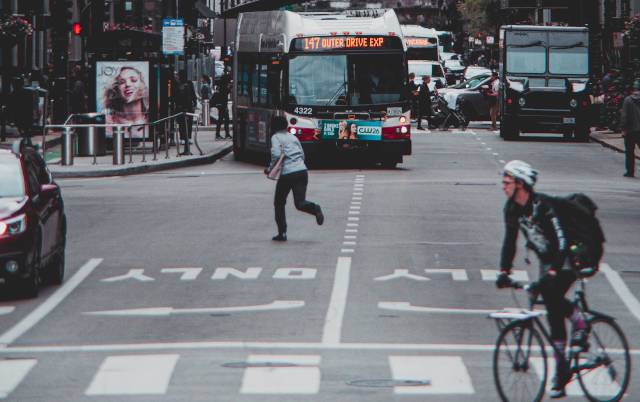For those of us who do not live within walking distance of our workplaces, biking to work is an increasingly popular – and environmentally friendly – way to get to the office.
But how far is too far? Balancing convenience and physical fitness can be a tricky proposition when choosing between several possible commuting options.
Even if you’re not an absolute beginner or haven’t been on your bike since childhood, taking up cycling as part of your daily routine can be beneficial no matter what shape you’re in!
In this post, we’ll discuss which factors should influence your decision on whether or not you should bike to work. It’s important to be honest with yourself about how much time and energy you are willing to commit.
At the end of the day, only you can decide what’s best: if it feels manageable, go ahead and give it a try – but don’t feel like you have to push yourself way past your limits just to stick with a plan!
So if you’re considering sticking with your plan to switch from driving or taking public transit to cycling in order to reduce your carbon footprint while still getting an effective exercise into your daily routine, read on!
Quick Answer
For the average cyclist, cycling between 10 and 20 miles per day is generally a sensible starting point. If you’re just starting out then it’s sensible to begin with smaller distances and gradually build up as your body gets used to the routine. 5-10 miles is achievable for most people if taken steadily, with mild routes taking an estimated 30-60 minutes each way.
Invest in a Reliable Bike
Commuting by bike is a great way to save money, get exercise, and reduce your environmental impact – but it’s important to invest in the right bicycle.
Spend a bit more on your bike and you’ll be rewarded with a reliable model that fits your body type and is comfortable to ride. Remember, you deserve better when you want a bike for daily commute.
Don’t go for the budget option of a $200 bike expecting it to last for years.
It will likely break down unpredictably – leaving you stranded miles from home or worse, coming apart from underneath you while you’re in traffic.
Instead, go to a bike shop and ask for their lowest-end commuter model; usually this is around $400 and well worth the investment. Hybrids are a good choice as they provide an easy, comfortable riding position perfect for city cyclists who share the roads with other vehicles.
Save yourself time, worries, and money in the long run by investing in a dependable bike at the beginning.
Read Also: How Long Does It Take To Bike 20 Miles

Current Fitness Level – How Fit Are You?
Your current fitness level is critical to determining how far you cycle. If you’re already in good physical condition, it’s relatively simple to cover the necessary distance for your commute.
On the other hand, if you’re just starting out, you need to be realistic about your goals and work up to them slowly.
It is important to consider how the miles can quickly add together over time – one day of 30 miles round trip may not seem like much for a fit individual, but five days in a row presents more of a challenge.
Experienced cyclists with a higher fitness level can go longer and faster compared to novices.
However, if you stick with consistent cycling for commuting purposes, you will definitely notice yourself improving over time as your body adapts and adjusts – within just weeks you may find that it takes much less time than when you first started. The distance will soon feel almost effortless!
Take Into Account The Terrain, Weather & Route
When trying to answer the question of ‘how far is too far to bike to work?’, there are many factors we must take into account other than your fitness and bike.
Firstly, it will depend entirely on the route you take – commuters may have the choice between a safe bike path with limited traffic or a shorter but potentially more risky route.
Furthermore, the terrain and weather conditions can play a significant role in how long it takes you to get to work as a tailwind will help you fly along and a headwind or hill can considerably slow your pace.
It is therefore difficult to measure an exact distance for this question as each individual’s commute may look extremely different from another’s.
However, no matter which route you take, biking to work has multiple advantages like enjoyable exercise and healthy air quality that make it worth considering.
Read Also: Why Fixed Gear Bikes Are Good For Commuting

Are You Prepared To Sweat On The Ride?
Commuting can be a challenging process for many, as the physical exertion of your journey can cause you to become sweaty and unkempt.
If you don’t mind getting sweaty during your commute, then a long journey by bike may wind up being just perfect for you.
On the other hand, if you can’t stand the idea of starting your day drenched in sweat, then there are ways around it. For those who work in formal jobs and have to appear neat, showering at the office before getting dressed may be the best option.
However, this is not always available to everyone, which is why regular stops on the commute are recommended.
Taking a break during long rides can allow you to rest, eat, hydrate and take care of any necessary grooming or clothing adjustments that need to be made.
These breaks will undoubtedly add more time onto your journey but if they help you to remain fresh it will be worth it. Alternatively you can opt to commute only if your workplace is close by.
My wife rides her bike three miles to work each morning and barely breaks a sweat on her leisurely ride.
But for my 8 miles ride I need to leave early and have showers at work. For those who don’t have the benefit of showering at their workplace, invest in extra clothes and supplies for freshening up after a bike ride.
Also Read: Best Bike Skirt (Cycling Skorts) for Women
Do You Know How to Fix Your Bike?
Knowing how to fix your bike can greatly affect the amount of time it takes you to get from A to B.
Of course, the longer your ride, the more likely something is going to happen; usually few accessories and a bit of know-how is all that’s needed.
From replacing a flat tyre or tightening loose bolts to keeping an emergency toolkit in your bag (tube patches, levers, pump, etc.), having these basics sorted will help you on most occasions.
However, some problems won’t be so easy to tackle – recently one cyclist found themselves in incredibly hot water after a few broken spokes and an entangled wheel.
Luckily services like Uber and Lyft are often easy enough to access so even huge problem need not stop your reaching your destination on time.

Always Obey The Traffic Rules
Riding bikes doesn’t mean you need not worry about traffic rules or the rules no longer applies. Yes, there are many traffic rules that are no longer relevant to a cyclist on bikes.
But there are a few common rules that still apply; for example, you need to stop at the signal, ride in a predictable manner, make yourself visible at night and use hand signals to communicate. There are different hand signals that you can use but least learn the most basic ones.
When riding its a good practice to maintain a safe distance from others and be watchful. If not necessary one should not move between lanes too often causing confusion.
Further one should avoid undertaking trucks or lorries at all costs unless quite experienced; commuting on a busy traffic. At last take it easy on your first ride; there is no need to go super fast maneuvering aggressively on roads drenched in sweat; as the reward is less than the increased risks of accident.
Read Also: Is It Legal To Ride A Bike On The Sidewalk?
Maximize Visibility & Wear A Helmet
Traveling to work on a bike can needs you to return after dust, sometimes late night. As expected, dark environments can mean cyclists are challenging to see, so cyclists must take precautions.
Bicycles should have a white light on the front and a red light on the back. In addition to lights, the bike needs reflectors to enhance visibility at night.
Furthermore, those commuting to work via bicycle should also invest in reflective clothing.
Make sure you always have a helmet, to protect yourself In the unlikely case of an accident. When crashing into a car or any other vehicle the most vulnerable part is your head.
If you are worried about your life and safety on road its better you follow the lanes and wear a helmet to protect your head. I personally prefer BASE CAMP Adult Bike Helmet ( Get it On Amazon ) with Rear Light for its great design, safety features, excellent fit, and great value.
In Conclusion, How Far is Too Far?
Although there are many factors to consider when determining what constitutes too far for a bike ride, the truth is that it ultimately comes down to an individual’s own preference and determination.
Everyone has their own limits and must decide what extremes they are willing to go in order to reach their goals. While some may consider biking ten miles too far, others may feel invigorated by such a challenge.
It all depends on having faith in yourself and believing, you can accomplish whatever it is that you set out to do.
There is no right or wrong answer as how far is too far – it’s all about personal endurance levels, dedication and ambition. No matter the outcome of your journey – whether you make it or not – you will always gain an invaluable experience that provides unique insight into who you are as a person.
So don’t be afraid to push yourself and see where your bicycle will take you!
Also Read,
Are Hybrid Bikes Good For Long Distance?
One Hand Cycling: How To Signal, Drink, Bike Without Falling









I would so love to be able to bike to work.
Thank you for sharing
I walked 2 miles to work. It can be done.
That’s impressive! Walking two miles to work is a great way to stay active and get some fresh air.